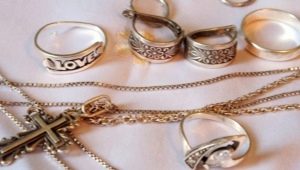Self-cleaning silver at home

Products made of precious metals are always relevant as jewelry, whether it be costume jewelry, souvenir and interior items or cutlery. Silver is considered the most versatile and affordable. It suits many, does not look too luxurious even in large quantities, and is much cheaper than other precious metals. However, silver and silver-plated jewelry is more prone to contamination and the formation of defects in the form of plaque, yellowness or blackening. Professional or self-cleaning of silver at home will help to solve any of these problems.
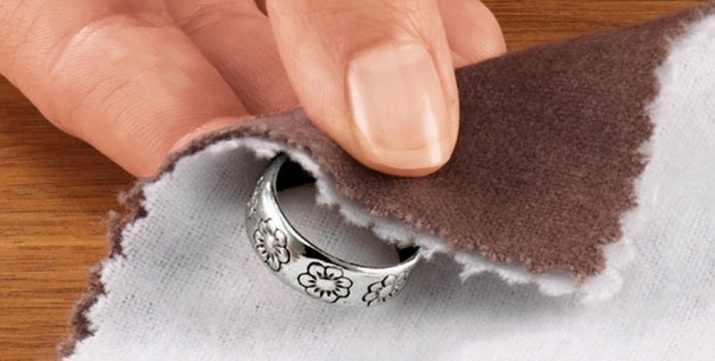
Causes of pollution
Over time, the appearance of silver deteriorates: yellowness, a reddish tint, or a black coating appear on it. Embossed and openwork jewelry made of silver jewelry may lose their expressiveness and brilliance. There are many opinions about the causes of such problems, ranging from improper care to the fact that damage was brought to the owner of the jewelry.The last statement is the most controversial, since there are a number of real objective reasons for the contamination of silver jewelry, both those that are actively used every day, and those that are taken out of boxes only on major holidays:
- Prolonged contact of silver products with oxygen. In the open air, the metal undergoes chemical reactions, and, as a result, a plaque forms on it, depriving the jewel of its luster. This is especially noticeable on table silver. Ideally, cutlery should have a "moonlight" appearance, but the oxidized coating makes it dull, like regular aluminum spoons.
- Interaction with skin secretion. Sweat and sebaceous glands on the human body work continuously, especially in case of increased activity or nervousness. In this case, the body releases a small amount of sulfur, which is enough for a chemical reaction with the metal. Because of it, silver acquires an unpleasant black coating. In order for jewelry to retain its soft radiance longer, it is necessary to remove them during sports activities, in case of illness and stressful situations.
- Increased humidity levels. The negative effect is especially noticeable on silver-plated items and jewelry imitating silver. From them, water literally washes away the silver coating.
- Influence of cosmetics. Many skin care products and types of decorative cosmetics contain sulfur and substances similar to it in their effect on metals. In combination with sweat and sebum, they destroy the original beauty of jewelry twice as fast. Chains and earrings are especially affected by this.
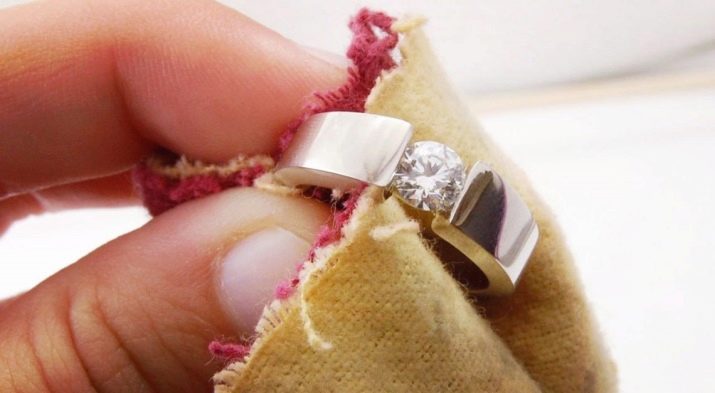
- Contact with household chemicals.Dishwashing detergents, powders, shower gels, shampoos, soaps, and other alkaline compounds will contaminate the top layer of silver jewelry, so it is recommended to remove jewelry before going to the shower, and use rubber gloves to wash dishes.
- Storage of jewelry in a common "heap". Silver of different samples contains different additives in its composition, which also negatively affect each other. In a common jewelry box, each product should be stored in individual packaging. It is desirable that this be a velvet bag, since air exchange does not occur in plastic bags.
- open storage. Exposure to sunlight does not blacken silver, but it loses its luster and becomes faded.
- Sudden changes in temperature and humidity. This especially affects the rings on the hands in the cold season.
- Lack of preventive care. From time to time, even pure silver needs to be rubbed with special napkins. This significantly increases the period of their stay in their original state.
- Low quality jewelry. In many respects, the occurrence of pollution is influenced by the composition of the metal. The least problematic in this matter are products of the highest standard - 999. There is practically no 100% silver on the jewelry market, since this metal itself is soft, easily crumpled, scratched, loses relief, openwork pattern, and with it attractiveness and jewelry value. For strength, a ligature is added to silver - copper, aluminum, zinc or nickel. The higher the percentage of impurity, the faster the yellowness, blackness or redness appears on the decoration.

The red color of the product gives a large amount of copper, and yellow and black - other additives.The minimum allowable fineness for table silver is 750 and 800 (three-digit fineness indicates the silver content per kilogram of the alloy). For jewelry, the silver content should be higher - from 830 to 999.
The most popular and reliable is sterling silver, from which coins were minted in England. The silver content in such an alloy is 916 grams.

What is the best way to wash?
The choice of a product for high-quality and safe cleaning of silver products is influenced by various factors.
Type of pollution
Many homemade products and ready-made professional formulations are versatile and work to restore shine, radiance and original color to jewelry. However, the type and degree of contamination can be different, and in order to renew the darkened silver, it will take a gentle composition and less time, and to clean the same product from obvious blackness, a more aggressive agent and a long-term effect. Also, in addition to pollution, silver also has troubles such as loss of luster or scratches. In each specific case, their methods are effective:
- Blackened silver. Black plaque, which mainly appears under the influence of hydrogen sulfide, is disposed of in various ways. In the arsenal of professionals there are ultrasonic procedures, powerful steam generators and wipes with special impregnation for polishing products. Among home recipes, compositions based on soda, chalk, foil, tooth powder, and ammonia are popular. Many of them involve boiling. Abrasive compositions (scratching) cope well with severe pollution, but you should be careful with them, since the grains of the substance can ruin the relief or openwork pattern on the decoration.
- Rusty metal. To tidy up silver products that have been affected by rust, you need to purchase a ready-made rust remover and follow the instructions or put the product in a container with ammonia. After a while, the product can be removed, wiped with a napkin and worn.
- Red plaque. It appears in two cases: either the copper in the alloy was oxidized, or the plaque appeared under the influence of another metal that was next to silver. In order to get rid of plaque, ready-made professional solutions and liquids are effective. They lower the product, periodically taking it out and blotting it with a napkin, or wiping it on top with a cotton swab.


- Yellowness. One of the most annoying types of pollution, because it makes silver look like a cheap fake. Appears from iodine and chlorine (even after going to the pool). The easiest way is to “mask” the yellowness with fresh starch. Products are rubbed with raw potatoes so that the yellowness changes color, and they become almost invisible. Soap-alcohol solution, soda, toothpaste and tooth powder also help.
- White plaque. Such a problem can occur both by itself and after trying to clean the blackness from the jewelry. White plaque is less noticeable than color, but from the side the product looks dull, devoid of the inherent radiance of silver. In this case, ammonia, hydrogen peroxide with the addition of baby shampoo, ready-made formulations and wipes impregnated with abrasive substances help well.
- Brown patina. It, as a rule, is formed on cupronickel products (silver imitation).The result of the oxidation of metals cannot be washed off mechanically; here it is necessary to use an aluminum-salt bath with hot water. Aluminum can be used in the form of wire or foil.
- Scratches and damage. Such defects can spoil the appearance of a silver product, even if it has not lost its luster. Scratches are especially noticeable on large jewelry and products with a smooth surface. You can restore them to their original appearance with the help of gentle grinding by hand. Various abrasive substances are suitable for this purpose - from emery cloth with the finest grain and silicone rings to a sewing needle. You can also get rid of scratches using a chalk solution, soda, GOI paste, polishing paper.

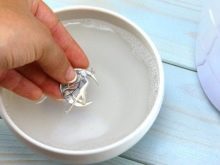

- Metal test. Many cleaning methods in one way or another imply a mechanical effect on the silver product. It is acceptable when working with silver up to 916, but must be gentle (cotton pad, cotton swab, very soft toothbrush, abrasive wipes). Products of the highest standard, in which the percentage of soft metal is almost equal to 100%, are shown in gentle ways. As a rule, this is immersion in solutions for a short time.
- Product type. All silver products can be divided into jewelry, interior items and cutlery. Table silver is the most durable and cheapest in composition. It is subjected to various types of cleaning and polishing without harm to the surface of the product. Interior decorations can be made of more expensive, softer and more capricious silver, but they are large, so they are easy to clean with wipes, ready-made sprays, brushes and other mechanical methods of influence.Jewelry, which has a greater material and artistic value, should be cleaned with care.
Incorrectly selected composition, at best, will not give a result, and at worst, it will completely ruin the product.
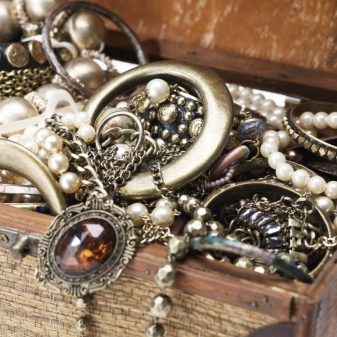
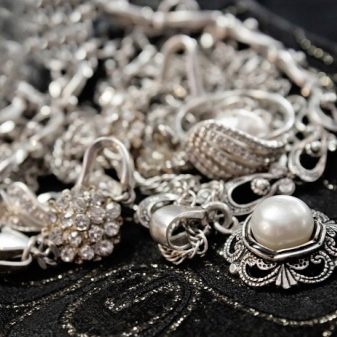
Type of silver
In addition to the sample, several more types of silver used in jewelry should be distinguished:
- Rodirovannoe. This is a precious metal coated with another precious metal of the platinum group. This coating makes silver jewelry as resistant to dirt and damage as possible. They do not fit, and do not need, home solutions and ready-made products. It is enough as a preventive measure to wipe them from time to time with soapy water and a special napkin for precious metals. It is especially convenient to purchase ready-made wipes for rhodium-plated silver if they are required for the care of watches. Rhodium, like silver, is afraid of sulfur, sweat, sebum, chlorine, aggressive chemicals. The best solution would not be to clean it, but to take care of the jewelry;
- Gilded. Thanks to gold plating, such silver is less capricious in care. For cleaning, natural suede, alcohol and turpentine in small quantities, a solution of vinegar in the proportion of 2 tablespoons per liter of water, soaking in beer, rubbing with a flannel cloth, ammonia, lipstick are used.
- Blackened. This is the most difficult type of silver to clean from contaminants. Usually, blackening is applied in the form of a pattern on a light background, which eventually loses its luster, acquires a coating, and fades. To clean it and not spoil the black drawing, you need to be very careful. Soapy-salt solution and rubbing with raw potatoes help here.

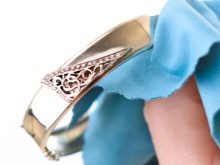

- drip. It is not a metal in nature, but a mineral known as marcasite. He does not tolerate contact with chemistry, alkali, alcohol. Only the most gentle cleaning methods can be used.
- Kubachinskoye. This is a very old silver, which was at the peak of popularity back in the 17th century, and it is very rare to find it today. It has a high artistic value and is distributed mainly among interior items. Due to its high quality, it is little susceptible to pollution, but lends itself to any type of processing. It is better to use organic substances for cleaning: lemon, salt, potatoes. Ammonia and soap solution will do.
- Sterling. Universal high quality silver of high standard. It is recommended to clean it with vinegar, peroxide, ammonia, jewelry wipes.
- The presence of parts from other precious metals, jewelry The presence of parts from other precious metals, jewelry in the form of stones and pearls. When choosing a cleaning method for combined jewelry, it is important to consider the properties of other metals or precious materials.


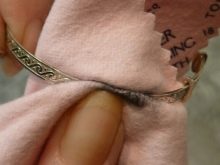
Washing with any solutions, rubbing and soaking in warm water is possible only for products with high-density stones (emeralds, sapphires, aquamarine). But you can’t lower them into hot water if the stone is not held on metal “legs”, but on glue.
For stones that have a less dense structure and are prone to mechanical damage, sparing products and baths are chosen. These include products with turquoise, malachite and moonstone.

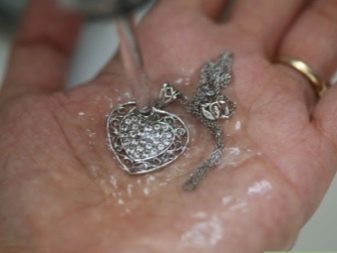
Some stones (garnet, ruby, topaz) lose color due to hot water and harsh chemicals. They are shown cold soft brushing.
Organic elements with increased sensitivity to alkaline and acid solutions (pearl, coral, amber) require special care. At home, they can cause irreparable harm.
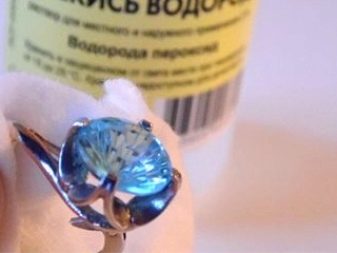

Cleaning speed
Sometimes dirt on silver is found shortly before an important event, then the jewelry needs to be cleaned as quickly as possible. Active solutions with ammonia, alcohol, boiling with copper and foil, brushing and abrasive substances help here. For unhurried cleaning, you can use long-acting soft solutions and use ultrasonic baths from specialists.

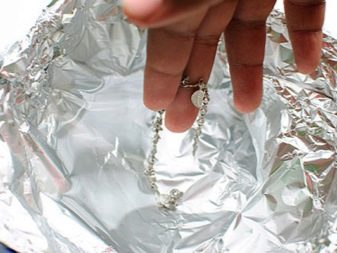
Cleaning cost
Silver is not the most expensive of the precious metals. If the product is small and has neither special material nor personal value, it is simply a pity to spend a lot of money on putting it in order. In this case, you should use simple recipes using peroxide (a bottle costs less than 20 rubles), soap and soda solutions.
A ready-made cleaning agent will cost a little more. It is suitable in case if the house has a lot of silver items and they are large.

The most expensive is the cleaning of silver by a jeweler using steam, ultrasound and special wipes. It is necessary for expensive jewelry, silver of the highest standard, family jewels, jewelry with high artistic value.


home remedies
Owners of silver jewelry often wonder what to prefer - home cleaning products or special formulations. There is no single answer to this question. Both hand-made compositions and those purchased in the store have both their pluses and minuses.
The advantages of home formulations include:
- Available components. Most popular recipes consist of products that everyone has in the house, as they are needed for medical purposes, household or personal hygiene;
- Profitability. A drop of liquid soap, a little foil, a piece of copper or a bottle of hydrogen peroxide will cost a penny, and the result is often good;
- No harm to health. There are no harmful fumes or corrosive substances in household cleaners;
- Ease of preparation;
- Interchangeability of the components of the composition;
- Fast effect.

There is only one minus of such funds, but a serious one is an unpredictable result. Even using a remedy tested by someone else, it is difficult to predict whether it will give an effect and whether it will be positive. It is possible that you will have to carry the completely ruined jewelry to the master.
The top ten most popular silver cleaners at home are mixtures using ammonia, pyroxide, bleaching and alkaline agents household and medical purposes. There are more original methods, where the main ingredient is raw onions, grated potatoes, carbonated drinks and even cigarette ash.
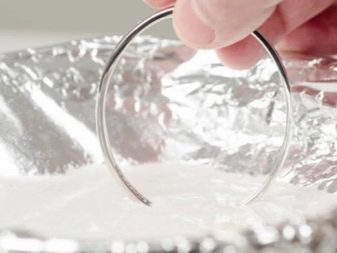

ammonia
One of the most common, effective and fast ways. The recipe for preparing the solution is very simple - you need to dilute 2 tablespoons of alcohol with one liter of water. Keeping the proportions, the volume is easy to increase or decrease. Strengthen the action of hydrogen peroxide and soapy, foaming substances in small quantities.
Items made of precious metal are dipped into the finished mixture for a quarter of an hour, then laid out on a felt cloth for wiping. The procedure is repeated until the desired result is achieved.

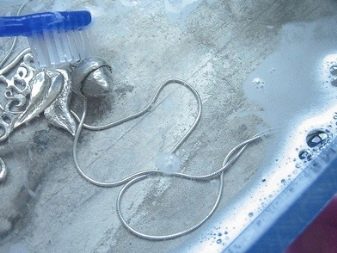
The solution relieves jewelry and silverware from blackening and dullness.
Salt
This method is suitable for items without stones and the addition of other metals. Salt is diluted in the proportion of 2 dessert spoons per 200 ml of liquid, and products are boiled in the resulting solution for 10-15 minutes. If you want to avoid boiling, jewelry is simply soaked in water with salt.
Replacing salt with baking soda will help speed up the process. It is added to water in a ratio of 1-2 tablespoons per 500 ml of water. After boiling for 15 minutes, the jewelry will shine like new. Also, the product is effective when soaked, followed by wiping with a felt napkin.

Toothpaste and tooth powder
Removing dirt from silver products with personal care products is acceptable if they are white and do not contain abrasive particles. Such a paste is applied in a small amount to a napkin or a very soft toothbrush and with light movements from the bottom up (always in one direction), the contaminated surface is treated.
Brushing with tooth powder is more effective when when the product needs soft polishing. The powder in this case is diluted with warm water to the consistency of a thick paste, applied to a napkin and problem areas are treated with it. A toothbrush is no longer needed here, as this will enhance the grinding effect.

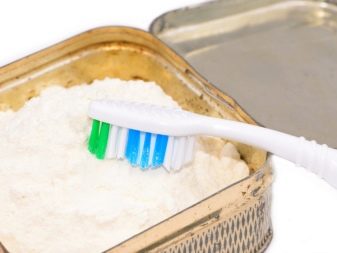
After treating the silver item with a dental agent, it is thoroughly washed under running water, dried and polished with a soft cloth.
with foil
By itself, the foil is not capable of returning silver to its original luster and purity, but in combination with other components, it works like a catalyst, starting chemical reactions.
Most often, foil is used for boiling.It is lined on the bottom and walls of the pan, water is poured into the pan so that it completely covers the foil, and then a small piece of copper wire or 15-20 g of baking soda is added to choose from. The mixture must be brought to a boil and a piece of silver should be lowered into it. Then they can be boiled for 5-15 minutes or put into a solution and not removed until cool.

As with any cleaning method, it is necessary to complete the procedure by thoroughly rinsing the products and polishing.
hydrogen peroxide
This antiseptic is known for its bleaching properties. It is able to return the proper "moonlight" shine to silver, but if used carelessly, it also gives the opposite effect.
For 1 liter of water, it is enough to take 100 ml of hydrogen peroxide. Lower the product into the resulting solution for 15-60 minutes. The holding time depends on the type of product. For thin chains, a quarter of an hour is enough, cutlery must be kept 3-4 times longer.

With very strong contamination, ethyl alcohol is added to the solution in the same amount as peroxide.
citric acid
Another way to restore shine to dull cutlery. To make them sparkle on the festive table, it is necessary to dilute two sachets of 50 grams of citric acid in half a liter of water. In addition, put a small piece of copper wire into the container with the solution.
It is better to heat such a mixture in a water bath. When the water boils, the fire can be reduced or turned off and darkened or dull silver is put into the hot water. Holding time - up to 20 minutes. For maximum effect, it is recommended to rinse and polish the product with a soft cloth.

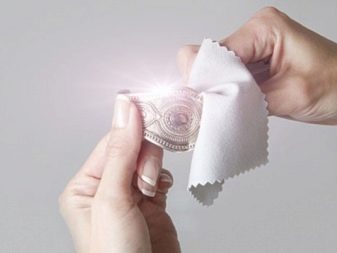
Vinegar
For this purpose, you will need ordinary table vinegar (not essence!) 6 or 9%.Vinegar is a simple and effective remedy, since it does not even need to be diluted with other liquids. It is enough to pour half a glass or other glass container and put jewelry inside that has lost its presentation. 60-80 minutes later they will sparkle like new, especially after polishing. Vinegar must be thoroughly washed off.
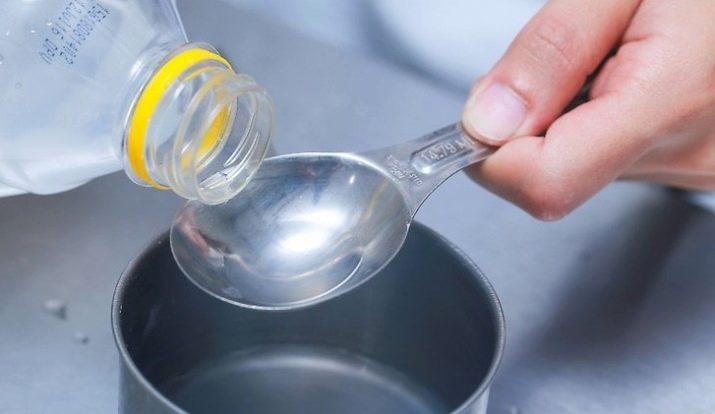
In addition to these common recipes, there are more original solutions. As a rule, this is a one-component substance that is frequently used and easily accessible:
- Olive oil. Suitable for removing mild dirt and plaque. The oil is applied to the polishing cloth and the product is rubbed well;
- Carbonated drinks. Cleaning with Sprite, Fanta, Coca-Cola is possible. They are used in their pure form for both cold soaking and boiling;
- Ashes from cigarettes. An effective method, but with a strong smell, since the entire contents of the ashtray must be poured into a pot of water and brought to a boil. Dip the silver into the hot solution for 10-15 minutes, then rinse well and polish;
- Yogurt. Its application does not require any extra effort. Jewelry is soaked in liquid for a quarter of an hour, taken out and polished;



- Potato. Fresh potatoes give the effect of a fine abrasive substance due to the presence of a large amount of starch in the composition. Potatoes are cut into thin slices and put in a container with water, silver is lowered there for 2-4 hours. Hot water is suitable after boiling potatoes;
- Lipstick. There are legends about the effectiveness of this method, but it is important to remember that lipstick contains wax and fats, which can then be problematic to remove from the surface of jewelry, especially textured ones.
- Eraser.
- Banana peel.
- Fixer for developing photographs.



Special formulations
Jewelry stores offer ready-made cleaning products for silver products. They also have a number of advantages:
- Manufacturer's warranties;
- Clear and effective composition;
- Application safety;
- Good and fast results.

Their disadvantages include a higher cost than a home remedy, and a limited shelf life. Also, this tool is not suitable for processing silverware, since the liquid is used in a concentrated form, and the cost of cleaning devices will be unreasonably high.
Today, jewelry cosmetics from four manufacturers are in demand on the domestic market:
- "Aladdin". A complete cleaning kit consists of a container with a solution, a basket in which it is convenient to lower jewelry into a container, and a special napkin for finishing polishing. The container comes in different sizes, including large sizes for interior and table silver, but the price increases along with the volume. The solution is not suitable for processing jewelry with fragments of organic origin (amber, coral, pearls) and enamel. The remaining products with dense stones and without stones are lowered into the solution for 10-20 seconds. With heavy pollution, the time increases, but not more than 1.5-2 minutes.
Since the solution is aggressive, it is recommended to use gloves to protect the skin of the hands. Aladdin napkins for polishing are purchased separately.

- Silbo. German-made jewelry cosmetics has a wider product line. It includes solutions, foams, and cleansing wipes. In addition to being less aggressive on silver, Silbo products additionally create a protective film on the surface.When using a liquid, jewelry is placed in a strainer from the kit and dipped into the solution for up to 8 minutes. The remains are washed off under running water and the surface is rubbed with a cloth. The foam is applied directly to the polishing cloth and the contaminated surface is treated with it. After thorough rubbing, the foam is left for 3-5 minutes, wiped again with a napkin, washed and polished.
This product should not be used on enamel parts, blackened silver or soft textured gemstones.
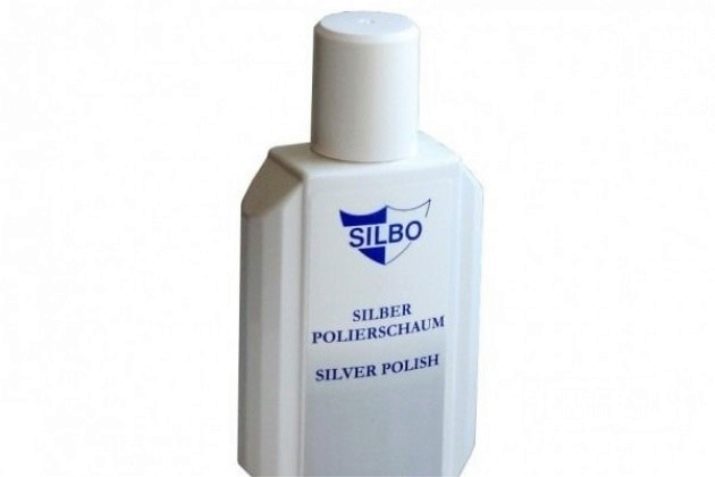
- "Turman". The principle of operation is the same as with Aladdin. This tool contains acid, which is contraindicated for pearl elements, blackening and enamel.
- "Mascot". The range of this manufacturer is the widest: solutions, foams, silverware, napkins. All types of cleaners contain acid, so the products are washed with soap and water after use and wiped with a cloth.


How can you clean quickly?
If there is very little time left before the publication or the visit of guests, and the festive silver turned out to be damaged by a black coating or noticeably reddened, there are several ways to quickly and effectively clean it at home.
The fastest result gives the finished product - "Aladdin". Its duration is less than two minutes. But there is simply not enough liquid for table silver, and not everyone has jewelry cosmetics at hand. But baking soda and aluminum in any form can be found in any home.
Aqueous and soda solution with the addition of aluminum copes with any contamination on silver, whether it be silver spoons, glasses, other cutlery and utensils, old silver (916, 925 or 999), chains, rings, earrings or fine jewelry.It is used with caution if silver is dripping, colored, or has enamel, stones, pearls as decoration. In this case it is better not to dip the jewelry into the solution, but dip a napkin into it and rub only the metal parts.


In order for silver to shine again and acquire a luxurious look, you need to take a 1-2 liter container (pot, ladle, bowl), line the bottom with aluminum foil. You can use any pure aluminum product by simply putting it in a pan, but foil in this case is more effective and more convenient. Then baking soda and water are added to the container at the rate of 1 tablespoon for every 500 ml of boiling water. It is important to pour soda with boiling water, and not add it to water in containers. - so the reaction will happen faster.
Jewelry that can be cleaned using alkaline substances is placed in hot water. Exposure time - 3-5 minutes. This is enough for a redox reaction to occur, eliminating plaque and contamination from the surface of the jewelry.

It is convenient to remove silver from hot water with a fork or drain the solution through a strainer. Then the jewelry is thoroughly washed with clean cool water and the procedure is completed by rubbing with a soft cloth. It is not recommended to use gauze, sponge or cotton cloth for this purpose.

Not all jewelry is suitable for such active cleaning. Marcasite, pearls and other organic inclusions require more careful care.
Jewelry with stones
Alkaline solutions, boiling, and aggressive components are not used to restore shine to jewelry with precious stones and a mixture of metals. They are suitable for jewelry cosmetics in the form of foam and napkins with special impregnation.
At home, the following actions are permissible:
- For cleaning jewelry with marcasite (drop silver). Marcasite is distinguished by its beauty and graceful appearance, but can easily lose its attractive appearance when using any chemistry. It can be cleaned with a cloth with a velvety surface, updated with a solution for silvering. Both products can be purchased in the boutique at the same time as jewelry.
- For jewelry with stones of a “loose” texture (pearls, amber, corals). Products with amber are soaked in warm water without the addition of cleaning agents, and then rubbed to a shine with a napkin. It is advisable not to wet the corals and not treat them with any means at all, but only rub the metal parts of the jewelry with a napkin in an abrasive solution.
- Jewelry with pearls can be soaked in a warm water-soap solution and rubbed with a napkin without touching the pearls themselves. It should dry on its own. If the surface of the pearls is dirty, they are lightly rubbed with dry potato starch.
- If cupronickel is used instead of silver (imitation of white silver from an alloy of copper and nickel for cutlery and inexpensive jewelry), the metal part of the jewelry can be cleaned with ammonia and peroxide, and the stone with water, soap, starch. But cupronickel refers to cheap materials and is more often used for the manufacture of silver cutlery.


How to wash silver plated items?
Cupronickel imitation of precious metal and silver-plated products are distinguished into a separate group. Despite the fact that they are relatively cheaper than real silver, their care must be of high quality, otherwise the products will quickly lose their gloss and begin to look like cheap aluminum trinkets.
Like many pieces of jewelry, silver-plated items tend to darken.It is possible to clean blackness with abrasive substances (tooth powder and brush, soda, starch, sponge), but it is not recommended. The silver layer on the product has a small thickness, and mechanical cleaning makes it thinner. The same applies to attempts to wash the product.
The best option for silver-plated products is soaking in a hot soda solution using foil, which neutralizes the color of the oxidized metal, restoring its radiance and brilliance.
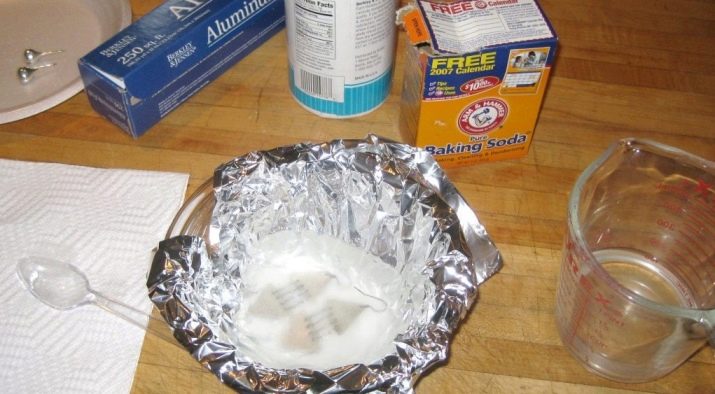
Care
Silver products have an impeccable appearance not from the one who cleans them correctly, but from the one who takes care of them properly. A number of preventive measures significantly extend the life of jewelry and silver items:
- Products must be stored separately from objects with sharp edges and from each other. Ideal storage conditions are a dry place where sunlight and oxygen do not fall. Velvet, felt or flannel fabrics are best used as bedding or individual packaging.
- Wipe them regularly with soft cloths (felt, flannel, special napkins).
- Do not get carried away with polishing - this thins the layer of metal.
- Use powdered and abrasive mixtures as little as possible, they scratch the surface of the product.
- Do not polish products with a regular sponge. Both of its sides leave scratches on the metal surface. They may not be noticeable after the first or second use, but over time they will make themselves felt.
- Before going to the shower, swimming pool or swimming in the sea, you must remove all silver jewelry from yourself. This rule also applies to active physical exercises, when the body intensively produces sweat and sebum containing sulfur.
- Protect silver rings and bracelets from contact with household chemicals during washing and washing dishes, removing them or using gloves.
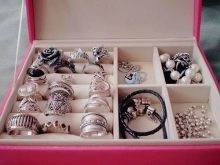


Visual ways to clean silver at home, you can learn from the video below.























